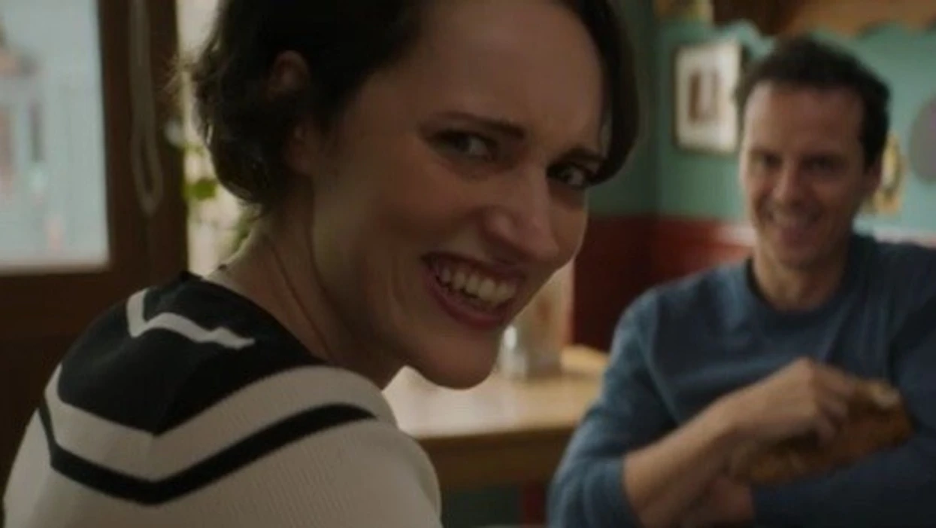
By Bella Retter
As viewers, we like to stay in our unviolated oasis, but when the actors turn their eyes on us, we are suddenly caught in the act. The act of what? You may ask. Uncontrollable consumership.
I, like most people currently, have an issue with binge-watching. Whether it’s a show I’ve already devoured a million times or a new show with the dreadfully short and intense 8-episode-per-season format, I still love to binge endlessly. In the United States, 99% of households are subscribed to a streaming service that supports the binge-watching model (Northwestern Medicine). 70% of Americans admit to binge watching, and that number is higher within younger generations (Prastien). This ‘binge-watching phenomenon’ is not just a me thing, or a you thing, it’s an everybody thing.
Arguably, the best part of binging is the satisfaction. I know what you’re thinking– and no, I’m not binging slime or kinetic sand videos (well, yes, sometimes, but that is not the point right now!). I believe there is something satisfying about gulping down a whole season or series in a short period of time. But this satisfaction hinges on one fact: that binging stays a guilt-free experience. As soon as we feel judged for our possibly unhealthy addiction to media consumption, it loses its satisfying quality, and arguably, its good feeling overall.
One place we see this shift from enjoyment to judgment is in the TV show Fleabag, in which the characters address the viewers directly. When the characters turn their gaze on us, our act of watching becomes part of the story. More than just clever or vulnerable writing—such moments reveal how uncomfortable we are with being seen as consumers, not just viewers.
In the past couple decades television has become more experimental and expansive; instead of every TV show following the same format, TV has grown with its audience and now reflects more of our world in the 21st century. However, some of the ways in which it does this do not necessarily portray us, the viewer, in the best light. One of these techniques is called “breaking the fourth wall.” Some people love it, some people hate it, but everyone can admit that it is very effective at calling out the audience.
Now what exactly is “breaking the fourth wall”? You may have heard the term from the overly pretentious kids in your high school play, but it’s actually a cool technique used in media. Breaking the fourth wall is when a character speaks directly to the audience, breaking the self-imposed barrier that says we do not exist to them.
The phrase is directly speaking to the setting of a stage. The stage can be thought of as a room, with four presupposed walls, the fourth wall being the one standing between the actors and the audience. When an actor leaves the story, or hits “pause” on it to talk directly to the audience, the world that we imagined them to be in cracks, and suddenly we are in some capacity a part of it. Although this technique is really fascinating, it is also startling, especially because in most genres breaking the fourth wall is uncommon. In noticing these fourth wall breaks, the audience has to recognize that they are not invisible; they are not just watchers, but players, too.
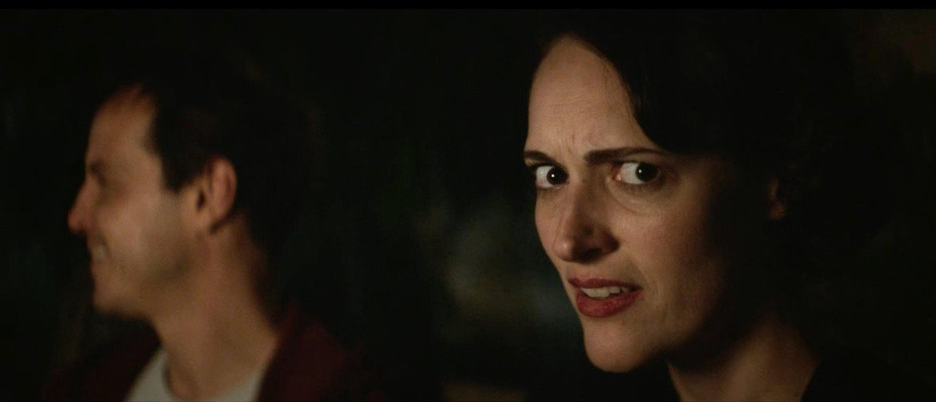
Fleabag, created and starred in by Phoebe Waller-Bridge, helped popularize breaking the fourth wall as a more well known trope. Originally made as her one-woman play over a decade ago, the show was introduced on BBC in 2016. The show follows Waller-Bridge as the unnamed main character, given the namesake “Fleabag” to show the lowest and most flawed part of her persona.
The audience may be immediately turned off by Fleabag’s characterization, as she is portrayed as selfish, destructive, and admittedly too fixated on sex. However, as the viewer sticks around, they see that these flaws humanize her. She is ultimately stuck in time after the death of her best friend, which she feels partly responsible for.
Throughout the entirety of Fleabag, Waller-Bridge’s character constantly breaks the fourth wall, creating a sense of a shared world with the audience. Her innermost thoughts are not construed through voiceover, which in turn would allow for space between the audience and the character; instead she speaks these thoughts directly to the audience. Sometimes she just shoots a pointed look, which says more than words ever could.
Although audiences have become familiar with fourth wall breaks in expected genres like mockumentaries (The Office, Parks and Rec, and more recently, Abbott Elementary), Fleabag is different. As a dramedy, it doesn’t use the “show inside of a show” format with staged interviews in which characters speak directly to the faux documentary crew. This makes the fourth wall breaks within Fleabag even more striking.
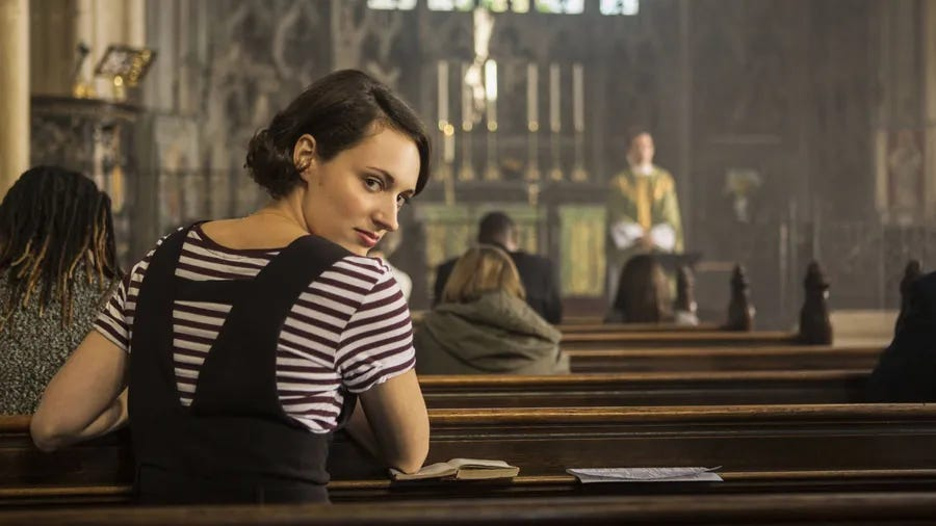
In the show’s first episode, for example, Fleabag and her sister are at a lecture waiting for a speaker to come on stage. Fleabag breaks away from their passive-aggressive small talk to speak to the audience directly: “The only thing harder than telling your super-high-powered-rich-anorexic-super-sister you have run out of money is having to ask her to bail you out. I’m just going to ask her… I’m just going to ask her… I’m just going to ask–” (S1E1, 10:34). She prepares to ask her, yet before she can say anything, her sister asks Fleabag if she needs money. Fleabag instinctively responds, “No!”– then looks back at the camera with an unwilling expression and states “Can’t do it, can’t do it” in her sardonic and humorous tone.
This moment displays the paradoxical nature of fourth wall breaks in Fleabag: the moment feels vulnerable and honest, yet Fleabag is still performing for the viewer. Fleabag could choose to just think to herself, or even truly confide in her sister, but instead she turns to us– the viewer, so that we are now a part of the performance, too. Her comedic timing is impeccable, but the moment is also deeply uncomfortable because she has included us in her avoidance and performance of control, which stems from her ability to use humour to cope, to reassure the viewer once again that “she’s fine!” As the critic Joan Vega observes “It is precisely during these seemingly intimate and revelatory fourth wall breaks that Fleabag is at her most performative. We see throughout the first season that she is always looking for attention to feel validated, to gain some sort of worth, and, as we later learn, to forget. And she knows she can get that attention easily any time she wants by just looking at us, by talking to us with that sardonic tone that is always sure to make us laugh” (Vega).
In moments like these, Fleabag changes the “normal” viewing experience: we are no longer the invisible spectators that we usually are when watching television. And this is what makes Fleabag’s fourth wall breaks so unsettling: they pull us into the character’s interiority, revealing not only their performance, but ultimately our own– our habit of watching without being watched and consuming without being held accountable. So in contrast to normal television, where we can silently judge the characters for their flaws, Fleabag doesn’t let us hide; instead, the show holds up a mirror.
This mirror allows the audience to see that we are also, just like Fleabag, avoiding the reality of our discomfort– both with binge-watching, and maybe even our broader habits of overconsumption. It then becomes up to us if we want to confront that knowledge and make a change. While Fleabag uses humour to cope with her best friend’s death and the bad habits that she develops as an effect, the audience can also focus on the show’s humour to avoid the uncomfortable feeling of being “seen” when they believe they shouldn’t be. It is easier to join Fleabag in her deflection than to point out the flaws within her performance. We can feel a brief moment of relief if we imagine our binge watching as coping, which saves us from real introspection on our discomfort.
The audience, then, has two options while viewing: we can join Fleabag in her avoidance, or we can examine why being “caught” makes us so uneasy. For those who choose to examine their habits, what they will find is that their discomfort is intrinsically tied to their act of consumption– whether it be binging-watching or beyond.
But even if we choose to join Fleabag in her avoidance of reality and performance that things are “alright,” that illusion becomes difficult to sustain when it’s not just Fleabag breaking the fourth wall. When someone else eventually breaks the fourth wall, it’s not just a mysterious twist in the narrative, it becomes a warning to the audience: there are no more deflections.
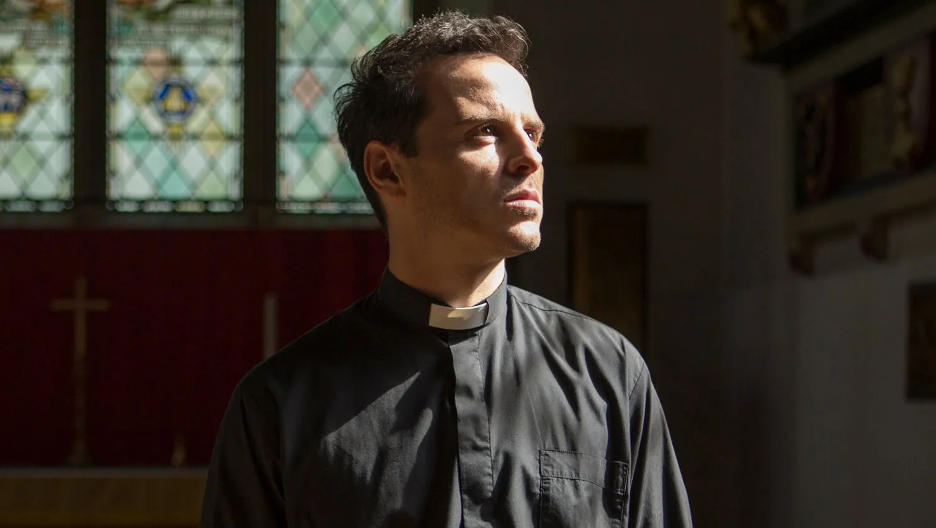
If the viewer makes it through season one, and all of the intense plot surrounding Fleabag’s grief and consistent affirmation that she is ‘fine’ (when she is most definitely not), then in season two, they will meet another unnamed character known as the Priest.
The Priest and Fleabag seem to have an undeniable romantic and sexual connection, which he is obviously trying to ignore based off of his priesthood. But what really makes the viewer start to care for the Priest is his intense understanding of Fleabag. Unlike anyone else in the show, he is able to acknowledge Fleabag breaking the fourth wall, even if he doesnt know what she is doing. In episode 4 of the second season, while they are having a conversation that turns to the topic of Fleabag’s friend who died, Fleabag uncomfortably breaks the fourth wall. The priest notices this and he states: “Where’d you– where’d you just go?” Fleabag replies, “What?” unable to grasp that he can see a part of her no one else can, and the Priest says back, “You just… went somewhere” (S2.E4).
Once the viewer sees this connection, they start to accept the Priest’s character. But when the priest also breaks the fourth wall, following Fleabag and looking directly into the camera, the viewer is startled again, as the show further breaks the already broken conventions of its reality. This time the viewer is not prepared for it.
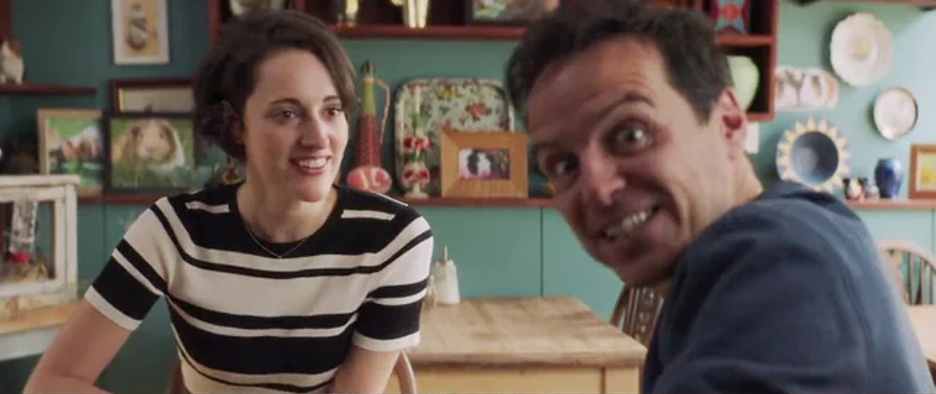
So, what happens when the Priest confronts the viewer—what exactly does the audience’s feeling of eeriness mean? It’s clear that in this context, and probably most, that the actor/director/writer is not chastising the audience for watching their show, which of course would be against the goal of mainstream TV. I believe that the feeling of eeriness may not even be a goal of the writers who include fourth wall breaks at all, or at least not a direct one.
Rather, this eeriness, or at times even shameful feeling of being “caught” is a side effect, something that comes from us and not from them. Instead of being able to deflect from our actions, like we, following Fleabag’s lead, may have done through Season 1, once the Priest catches us using the same coping mechanism as her, we find that we are no longer able to hide.

When we binge watch shows like Fleabag, we engage in casual anonymity—the act of indulging in our guilty pleasure without anyone watching. Other examples might include buying your entire cart off of Amazon when you know you shouldn’t, ordering a huge meal on mobile to avoid the cashier, or creating an anonymous spam account just to leave hundreds of hate comments. Ultimately, most people feel nothing from these kinds of acts, or at least nothing negative. Because we can hide. So when the Priest catches us– curled under a blanket, chips in hand at 3 in the morning– we’re not just startled, we’re uncomfortable. We feel seen, but not in the poetic sense that we would hope to be.
Just like the actors in Fleabag, I’m not chastising anyone. Like I said before, there is nothing quite like devouring a season whole on your day off (and if I order a venti frappuccino there is no way I’m not doing it through the app). But I am asking you to examine why you feel caught red-handed, because that discomfort tells us more about ourselves than it does any TV show.
In the end, the negative feelings that come from fourth wall breaks are not from Fleabag’s vulnerability (which is actually what makes the show so beloved), they’re from the shock factor of being noticed where we thought we were able to be invisible. The fourth wall breaks don’t just ask us why we are watching, but why do we feel the need to hide? And why do we feel safest so unseen?
The next time you decide to indulge in your consumption, whatever those habits might be, don’t imagine your favorite actor, or even society staring you down. Imagine yourself. In a world where hiding is unbelievably easy, becoming self-aware about your habits is the only true fourth wall break. Within that moment of recognizing how you feel about your own consuming habits and possible overindulgence, you will find the most honest kind of satisfaction there is.
Works Cited
Fleabag, created by Phoebe Waller-Bridge, Two Brothers Pictures, 2016. Amazon Prime, www.primevideo.com.
Northwestern Medicine. “Binge-Watching and Your Health.” Northwestern Medicine, www.nm.org/healthbeat/healthy-tips/emotional-health/binge-watching.
Prastien, Lauren. “Platforms Are Letting US Binge-Watch, but Maybe They Shouldn’t.” Carnegie Mellon University’s Heinz College, www.heinz.cmu.edu/media/2019/March/binge-watching.
Vega, Joan. “How Fleabag Reimagines Fourth Wall Breaks.” Film Studies Florida International University, 26 Apr. 2023, film.fiu.edu/how-fleabag-reimagines-fourth-wall-breaks/.
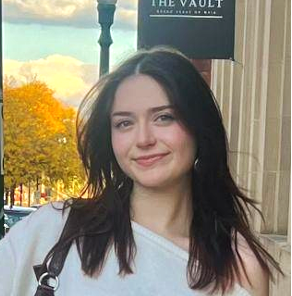
Bella Retter is an English and Professional Writing Student at SUNY Cortland going on to get her Masters in English. She is also the Communications Officer for Sigma Tau Delta the English Honors Society at Cortland. Bella has immensely enjoyed working as a Managing Editor for Emblaze and is excited to submit more writing in the future. Bella enjoys writing fiction, poetry, cultural criticism, and creative non-fiction. When she is not writing, you can normally find her reading one of her favorites: Joan Didion, Toni Morrison, or Sally Rooney.